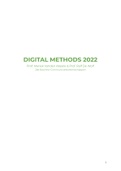Samenvatting
Samenvatting DIGITAL METHODS 2022
- Instelling
- Universiteit Gent (UGent)
Volledige samenvatting van alle lectures van Digital Methods olv Prof. Mariek Vanden Abeele & Prof. Ralf De Wolf. Alles behalve de gastlessen. De belangrijkste theoretische zaken voor het examen grondig samengevat en vaak uitgelegd in het nederlands én engels.
[Meer zien]



